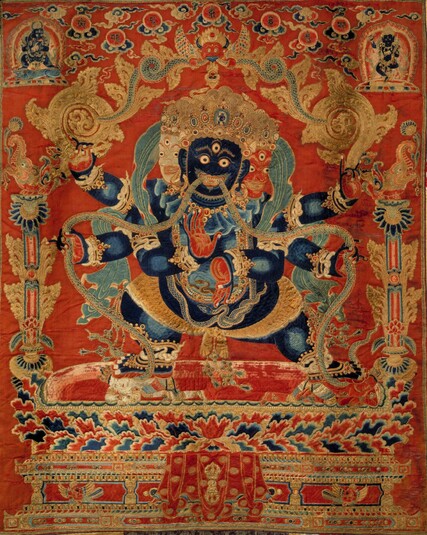
Item: Vajrapani (Bodhisattva & Buddhist Deity) - Mahachakra
| Origin Location | China |
|---|---|
| Date Range | 1400 - 1499 |
| Lineages | Buddhist |
| Material | Ground: Textile Image, Embroidery |
| Collection | Rubin Museum of Art |
Classification: Deity
Appearance: Wrathful
Gender: Male
Vajrapani, Mahachakra (Tibetan: chag na dor je, kor lo chen po. English: The Great Wheel Vajra Holder). Mahachakra is a Tantric form of the bodhisattva Vajrapani appearing as a meditational deity - regarded as completely enlightened. Just as there are many forms of Vajrapani, so also are there many varieties of Mahachakra both with consort and without. (See the Vajrapani Main Page, Mahachakra Main Page and the Vajrapani Outline Page).
Sanskrit: Vajrapani Tibetan: chag na dor je
Tibetan: chag na dor je
Mahachakra, wrathful in appearance, is blue in colour with three faces and six hands. The central face is blue right white and left red. Adorning the center of the crown of the central face is a small wrathful two armed Krodha Vajrapani. For the six hands the upper right hand holds a golden vajra scepter aloft. The upper left hand is in a wrathful gesture. The two middle hands hold two giant serpents while biting down on the heads - unseen in the mouth of Mahachakra - while treading on the tails. The two principle hands at the chest perform a wheel gesture (mudra). Wearing both peaceful and wrathful attire, a blue cape and tiger skin skirt, he stands with the right leg bent and the left straight atop the prone forms of two heavenly figures, sun disc, multi-coloured lotus blossom and kinnara supported jeweled throne - surrounded by pillars and an elaborate throne back, arched gateway (torana).
At the top center of the composition is the letter hum written in the Ranjana script (lantsa) in a discrete red and yellow bordered sphere. Beginning on the proper right side of the textile are Tibetan letters representing the syllables om vajra pa each in their own discrete red and yellow bordered sphere. On the following side are the syllables ni hum phat. The combined letters and syllables create the common mantra of Vajrapani: Om vajrapani hum phat along with the seed syllable (bija) hum
Textual Description: (from the Mitra Gyatsa) "...above a lotus and sun seat, Brahma and Indra, is Vajrapani with a blue cape, three faces and six hands. The right [face] is white, left red, each with three eyes. With six hands, the first two hold a vajra and a wrathful gesture upraised. The middle two are folded respectfully embracing the consort ... possessed of beauty, blue [in colour], holding a curved knife and skullcup. The lower two grasp a snake, at the [level of the] waist, as food. The right leg is bent, left straight." (Description: rgyud sde kun btus, vol.23, folio 215).
Lineage: Vajradhara, Vajrapani, Dakini Simhamukha, mahasiddha Shavaripa, Maha Pandita Javaripa, Pandita Devapurnamati, the translator Gar Chokyi Zangpo, kalyanamitra Rinchen Ngodrup, Mar Chokyi Gyaltsen, Mar Sherab Dorje, Mar Tubpa Sherab, Mar Tsondru Dorje, Mar Chogyal Sherab, Mar Shakya Drubpa, etc. (Extracted from the rgyud sde kun btus, vol.30, folio 75-6).
Bibliographic reference: Arya Nilambaradhara Vajrapani Rudratri Vinaya Tantra-nama, Toh 454, 455 and No.46 in the Gyu de kuntu set of mandalas.
Jeff Watt 1-2011
This textile composition of Vajrapani executed in a Chinese embroidery technique is regarded as one of the best examples of its type found in any collection worldwide. Observed closely, small beads of red coral and white pearls have been added as real ornaments and decorations. They can especially be seen decorating the hair of Mahachakra Vajrapani. Throughout the textile composition the thick gold threads are actually hair wrapped with real gold wire. (See other Textile Masterworks and Vajrapani Masterworks).
Subject: Masterworks Main Page (大师之作主页, ཕུལ་བྱུང་གི་སྒྱུ་རྩལ་ཁག།)
Publication: Selection of Works - Painting (RMA)
Thematic Sets
Buddhist Deity: Vajrapani, Mahachakra (Solitary)
Buddhist Deity: Vajrapani Masterworks (Paintings, Wrathful)
Buddhist Deity: Vajrapani, Wrathful (Early Paintings)
Buddhist Deity: Vajrapani, Mahachakra (Masterworks)
Subject: Art Evaluation Criteria (Traditional Painting)
Collection of Rubin Museum of Art: Painting Main Page
Subject: Art Evaluation Criteria
Collection of RMA: China (Painting Masterworks)
Collection of Rubin Museum of Art: Vajrapani Masterworks
Collection of Rubin Museum of Art: Vajrapani Painting Masterworks
Textile: Embroidered Artwork Main Page
Buddhist Deity: Vajrapani, Mahachakra Page
Collection of RMA: Best of Collection 1
Collection of RMA: How or Why an Object was Acquired
Collection of RMA: Textile Masterworks
Buddhist Deity: Vajrapani (Iconic Figures)
Buddhist Deity: Vajrapani, Wrathful (Names & Traditions)
Textile: Masterworks (纺织品, འཐག་དྲུབ་མ།)
Subject: Wrathful Deities & Function
Collection: Christie's, Painting (March , 2002; NY)
Textile: Main Page
Textile: Medium, Precious Stones
Buddhist Deity: Vajrapani Main Page
Collection of Rubin Museum of Art: Textile Page








